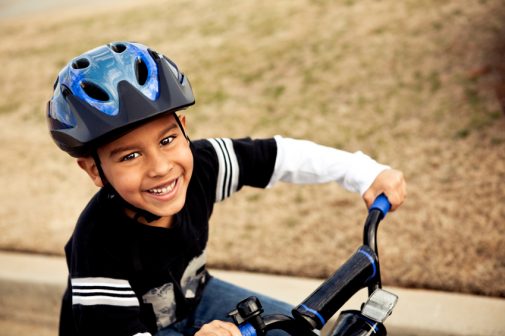Do you know the ABCs of a safe bike?

With warmer days on the way, kids are heading outside and breaking out the bikes. Alix McNulty, an injury prevention coordinator at Advocate Children’s Hospital in Oak Lawn, Ill., offers the following tips to make sure your children pedal their ride on the safe side.
Remember your ABCs.
Checking your child’s bike to make sure it is safe is as easy as A-B-C:
- A is for air. Check the tire pressure, spin the wheels and make sure they are not worn out.
- B is for brakes. Take a look at the hand brakes by lifting the bike up, spinning one wheel and squeezing the brake level to make sure the tire stops. Check the coaster, or back pedal brakes, by spinning the back wheel and applying the brake. The brake pads be clean, straight and make proper contact with the rims.
- C is for cranks, chain and cogs. Grab the crank arms, the part of the bike on which the pedals are attached, and wiggle side to side. There should be no movement, and you should be able to see the metal of the chain, free of dirt, rust and residue.
Use your head when choosing a helmet.
There is more to selecting a helmet than making sure your child likes the way it looks. McNulty says the most important thing is the fit.
“Helmets come in different shapes and styles, as do heads. A properly fitting helmet should sit securely on the head with no more that one to two finger widths above the eyebrows,” she says.
Straps should not be twisted and should form a “V” shape under the ears. No more than one to two fingers should fit between the strap and the neck. “Some children will complain that they are choking, but if they can swallow and talk, the helmet is not too tight,” encourages McNulty. She says that as children grow, so should their helmets, and that helmet resizing may be appropriate every season. “If the helmet is ever in an accident, has pieces falling off or is cracked, it should be replaced.”
Wipeouts are okay.
“Remember that children learn by making mistakes, so an occasional tumble from their bike is a great way to help them learn how to make proper self-adjustments while riding,” she says. “Nobody likes to fall, but teaching a child that it’s okay to get ‘back on the horse’ will promote self-confidence and a sense of personal achievement.”
Decide when to toss the training wheels.
According to McNulty, there is no set age at which a child’s training wheels should be removed. “The decision depends on his or her confidence and ability level. Make sure your child is able to properly balance and feels ready for the transition,” she says.
Location, location, location!
McNulty says it is important to make sure your child is learning to ride a bike on a level surface free from debris, sidewalk gaps and holes.
“Wherever a child learns, make sure it is not in an area of heavy traffic. It’s easy to learn how to go. Stopping, on the other hand, can get lost in the excitement!”
You can purchase a low-cost helmet and have your child’s helmet fitted by a trained professional at the Andrew Family Children’s Health Resource Center at Advocate Children’s Hospital in Oak Lawn every Monday from 10 am – 3:30 pm. For more information or to set up an appointment, please call the Center at 708-684-3225.
And remember that bike safety isn’t a one-way street; set an example for your children by keeping your own bicycle in top shape and always wearing a helmet.
Related Posts
Comments
About the Author
Holly Brenza, health enews contributor, is a public affairs coordinator on the content team at Advocate Health Care and Aurora Health Care. She is a graduate of the University of Illinois at Chicago.

















